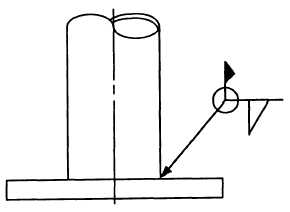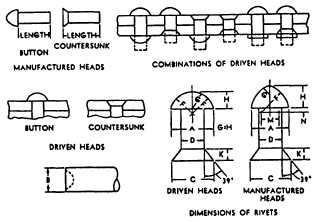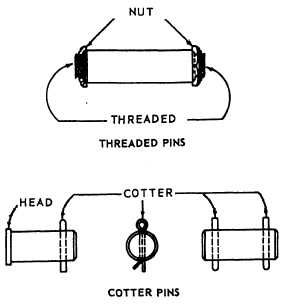Figure 1-51.—Example of a welding symbol in use.
Figure 1-52.—Pins for structural steel connections.
pins. (See fig. 1-52.) Threaded pins are held in place
after insertion by threaded recessed nuts on both ends
of the pin. Cotter pins are held in place by small cotters
that pass through holes drilled in the pins. Washers and
separators, made from lengths of steel pipe, are used to
space members longitudinally on pins. Holes for small
pins are drilled; larger pinholes are bored.
Rivets
Rivets are manufactured of soft steel in various
nominal sizes and lengths. The sizes most often used in
structural work are 3/4 inch and 7/8 inch in diameter.
The lengths differ according to the thickness of
materials to be connected. Rivets are inserted in the rivet
Figure 1-53.—Structural rivets.
holes while the rivet is red hot; consequently, the holes
are drilled or punched 1/16 inch larger in diameter than
the nominal diameter of the cold rivet.
Rivets are manufactured with one whole head
already fixed. The rivet shank is cylindrical and the
second head is formed by driving it with a pneumatic
hammer. The rivet set, which is inserted in the end of the
hammer, has a cavity of the proper shape to form the
head of the rivet. Most Structural rivets are two full heads
(fig. 1-53). Manufactured heads of rivets may also be
obtained in countersunk shape to fit into holes
countersunk in the material to be connected. When a
driven countersunk head is to be formed, the rivet is
driven with a flat-ended rivet set to fill the countersunk
cavity in the material.
QUESTIONS
The following questions are strictly for your use in
determining how well you understand the topics
discussed in this chapter AND IN THE REFERENCES
SPECIFICALLY CITED IN THIS CHAPTER. The
intent of these questions is to help you learn the topics
contained in the chapter and in the references.
Remember, when you participate in the advancement
examination for EA2, you may be asked questions that
are drawn not only from this TRAMAN, but from the
cited references as well. Therefore, it is to your benefit
to answer the review questions. You do NOT have to
submit your answers to these review questions to
anyone for grading. Similar review questions will be
included at the end of each chapter of this TRAMAN.
After answering the questions, you may turn to appendix
VI of this book to see how well you performed.
1-27






